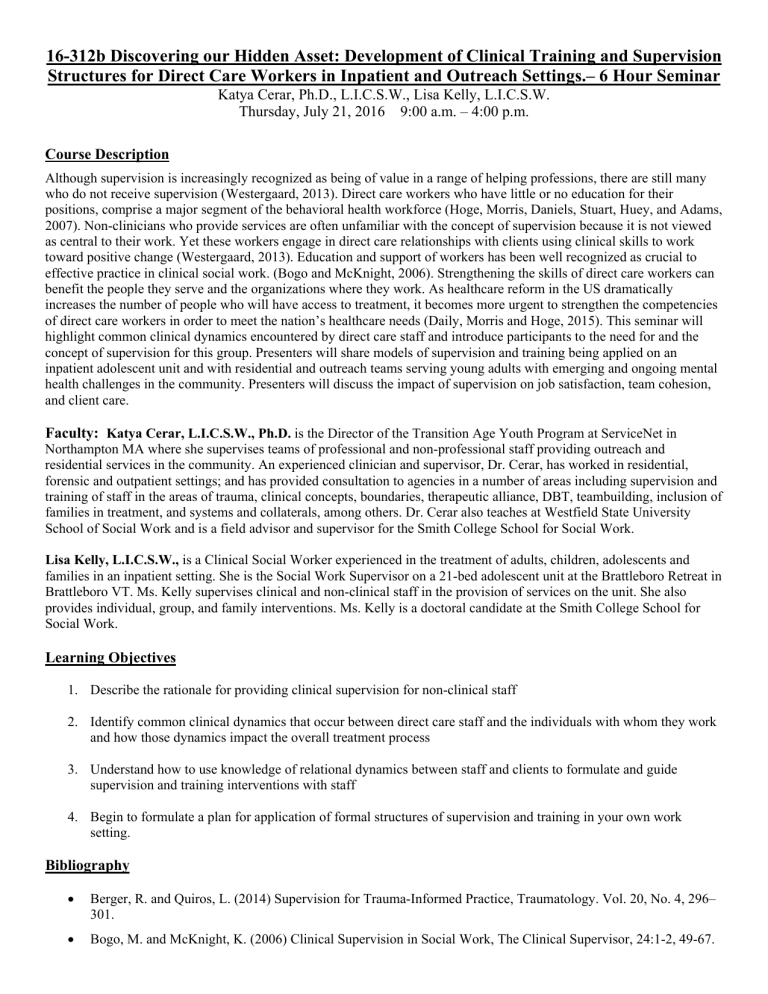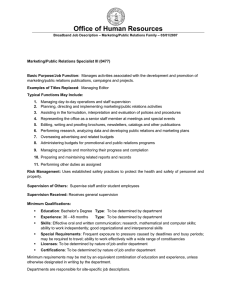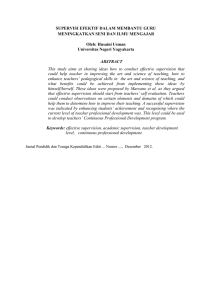16-312b Discovering our Hidden Asset: Development of Clinical Training and... Structures for Direct Care Workers in Inpatient and Outreach Settings.–...

16-312b Discovering our Hidden Asset: Development of Clinical Training and Supervision
Structures for Direct Care Workers in Inpatient and Outreach Settings.– 6 Hour Seminar
Katya Cerar, Ph.D., L.I.C.S.W., Lisa Kelly, L.I.C.S.W.
Thursday, July 21, 2016 9:00 a.m. – 4:00 p.m.
Course Description
Although supervision is increasingly recognized as being of value in a range of helping professions, there are still many who do not receive supervision (Westergaard, 2013). Direct care workers who have little or no education for their positions, comprise a major segment of the behavioral health workforce (Hoge, Morris, Daniels, Stuart, Huey, and Adams,
2007). Non-clinicians who provide services are often unfamiliar with the concept of supervision because it is not viewed as central to their work. Yet these workers engage in direct care relationships with clients using clinical skills to work toward positive change (Westergaard, 2013). Education and support of workers has been well recognized as crucial to effective practice in clinical social work. (Bogo and McKnight, 2006). Strengthening the skills of direct care workers can benefit the people they serve and the organizations where they work. As healthcare reform in the US dramatically increases the number of people who will have access to treatment, it becomes more urgent to strengthen the competencies of direct care workers in order to meet the nation’s healthcare needs (Daily, Morris and Hoge, 2015). This seminar will highlight common clinical dynamics encountered by direct care staff and introduce participants to the need for and the concept of supervision for this group. Presenters will share models of supervision and training being applied on an inpatient adolescent unit and with residential and outreach teams serving young adults with emerging and ongoing mental health challenges in the community. Presenters will discuss the impact of supervision on job satisfaction, team cohesion, and client care.
Faculty:
Katya Cerar, L.I.C.S.W., Ph.D. is the Director of the Transition Age Youth Program at ServiceNet in
Northampton MA where she supervises teams of professional and non-professional staff providing outreach and residential services in the community. An experienced clinician and supervisor, Dr. Cerar, has worked in residential, forensic and outpatient settings; and has provided consultation to agencies in a number of areas including supervision and training of staff in the areas of trauma, clinical concepts, boundaries, therapeutic alliance, DBT, teambuilding, inclusion of families in treatment, and systems and collaterals, among others. Dr. Cerar also teaches at Westfield State University
School of Social Work and is a field advisor and supervisor for the Smith College School for Social Work.
Lisa Kelly, L.I.C.S.W., is a Clinical Social Worker experienced in the treatment of adults, children, adolescents and families in an inpatient setting. She is the Social Work Supervisor on a 21-bed adolescent unit at the Brattleboro Retreat in
Brattleboro VT. Ms. Kelly supervises clinical and non-clinical staff in the provision of services on the unit. She also provides individual, group, and family interventions. Ms. Kelly is a doctoral candidate at the Smith College School for
Social Work.
Learning Objectives
1.
Describe the rationale for providing clinical supervision for non-clinical staff
2.
Identify common clinical dynamics that occur between direct care staff and the individuals with whom they work and how those dynamics impact the overall treatment process
3.
Understand how to use knowledge of relational dynamics between staff and clients to formulate and guide supervision and training interventions with staff
4.
Begin to formulate a plan for application of formal structures of supervision and training in your own work setting.
Bibliography
Berger, R. and Quiros, L. (2014) Supervision for Trauma-Informed Practice, Traumatology. Vol. 20, No. 4, 296–
301.
Bogo, M. and McKnight, K. (2006) Clinical Supervision in Social Work, The Clinical Supervisor, 24:1-2, 49-67.
Crowe, T.P, Oades, L.G., Deane, F.P., Ciarrochi, M., and Williams, V.C., (2011) Parallel processes in clinical supervision: Implications for coaching mental health practitioners. International Journal of Evidence Based
Coaching and Mentoring. Vol. 9, No. 2.
Dailey W. F., Morris, J.A., Hoge, M. (2015) Workforce development innovations with direct care workers: Better jobs, better services, better business. Community Mental Health Journal, 51:647–653.
Hoge, M. A., Morris, J. A., Daniels, A. S., Stuart, G. W., Huey, L. Y.,and Adams, N. (2007). An action plan for behavioral health workforce development: A framework for discussion. Substance Abuse and Mental Health
Services Administration Publication No. 280-02-0302.
Rockville, MD, U.S. Department of Health and Human Services.
Westergaard, Jane (2013) Line management supervision in the helping professions: Moving from external supervision to a line manager supervisor model, The Clinical Supervisor, 32:167–184.


